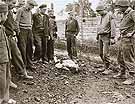
|
|
|

|

|

|

|
|
Click on an image to see a larger, more detailed picture.
|
|
|
|
|
| 1945: Liberation and Rebuilding |

|
pg. 623 |

|
|
|
|
| |
 Camp guards often executed inmates as the Allied armies approached. Here, commandant Eichelsdörfer of the Kaufering III concentration camp at Landsberg, Germany, is forced by American liberators to stand amidst the emaciated corpses of hundreds of the camp's victims, many of whom had been shot as the Americans drew near. Kaufering III was a subcamp of Dachau.
Camp guards often executed inmates as the Allied armies approached. Here, commandant Eichelsdörfer of the Kaufering III concentration camp at Landsberg, Germany, is forced by American liberators to stand amidst the emaciated corpses of hundreds of the camp's victims, many of whom had been shot as the Americans drew near. Kaufering III was a subcamp of Dachau.
Photo: UPI/Corbis-Bettmann
|
 Camp survivors often sought revenge against their former captors, especially those who had been particularly vicious. Here, at the camp at Gusen, Austria, a small crowd of liberated prisoners and American soldiers scrutinizes the dead body of a camp guard, who was killed by some of his former charges.
Camp survivors often sought revenge against their former captors, especially those who had been particularly vicious. Here, at the camp at Gusen, Austria, a small crowd of liberated prisoners and American soldiers scrutinizes the dead body of a camp guard, who was killed by some of his former charges.
Photo: Wilfred McCarty/United States Holocaust Memorial Museum Photo Archive
|
|
Victims and Statistics On June 28, 1941, German forces conquered the Belorussian city of Minsk. The Germans had killed thousands of its 80,000 ghettoized Jews by mid-autumn, but Masha Bruskina, a 17-year-old girl, was among the Jews who resisted. The Germans caught her, and she was hanged on October 26. Starvation, forced labor, shooting, gassing...Nazi Germany destroyed European Jews and millions of non-Jews in many ways, but each person perished one by one. Individual deaths multiplied into mind-boggling statistics. One leading Holocaust scholar, Raul Hilberg, estimates that 5.1 million Jews perished in the Holocaust. Most scholars now believe that the Jewish death total approached six million. Israel Gutman and Robert Rozett, for example, put Jewish losses between 5,596,000 and 5,860,000. German scholar Wolfgang Benz lists the figure at 6.1 million. The estimates of deaths vary widely for several reasons: the years and geographical boundaries used to determine prewar census data, the margins of error in death reports from German and Jewish sources, the difficulties of comparing prewar and postwar populations, and the fact that the Germans and their collaborators did not record the death of every victim. Every reliable judgment finds that nearly two-thirds of the European Jews--and one-third of the Jews in the world--were killed in the Holocaust. Hitler intended to obliterate all Jewish life--root and branch. The staggering number of those who indeed met their deaths demonstrates how close he came.
|
|

|

|

|

|
 May 6, 1945: The U.S. 11th Armored Division liberates the concentration camp at Ebensee, Austria. Nearly 10,000 bodies are discovered in an enormous communal grave. 3500 inmates remain alive; however, many of these survivors die from overindulging in food innocently offered to them by the Americans.
May 6, 1945: The U.S. 11th Armored Division liberates the concentration camp at Ebensee, Austria. Nearly 10,000 bodies are discovered in an enormous communal grave. 3500 inmates remain alive; however, many of these survivors die from overindulging in food innocently offered to them by the Americans.
|
 May 7, 1945: Germany signs an unconditional surrender at U.S. General Dwight D. Eisenhower's headquarters at Rheims, France. The fighting in Europe is to end at 11:01 p.m. on May 9; See May 8, 1945.
May 7, 1945: Germany signs an unconditional surrender at U.S. General Dwight D. Eisenhower's headquarters at Rheims, France. The fighting in Europe is to end at 11:01 p.m. on May 9; See May 8, 1945.
|
 May 7, 1945: Breslau, Germany, is captured by Soviet troops after an 82-day siege.
May 7, 1945: Breslau, Germany, is captured by Soviet troops after an 82-day siege.
|
 May 7, 1945: Dutch Nazi leader and collaborator Anton Mussert is arrested.
May 7, 1945: Dutch Nazi leader and collaborator Anton Mussert is arrested.
|
 May 7, 1945: Hungarian novelist Andor Endre Gelleri, age 38, dies at the Mauthausen, Austria, slave-labor camp two days after liberation.
May 7, 1945: Hungarian novelist Andor Endre Gelleri, age 38, dies at the Mauthausen, Austria, slave-labor camp two days after liberation.
|
 May 8, 1945: V-E (Victory in Europe) Day: The Allies accept the unconditional surrender of Germany.
May 8, 1945: V-E (Victory in Europe) Day: The Allies accept the unconditional surrender of Germany.
|
 May 8, 1945: The Red Army liberates the concentration camp at Gross-Rosen, Germany.
May 8, 1945: The Red Army liberates the concentration camp at Gross-Rosen, Germany.
|
 May 8, 1945: Allies capture Hermann Göring.
May 8, 1945: Allies capture Hermann Göring.
|
|
|
|
|
| 1945: Liberation and Rebuilding |

|
pg. 623 |

|
|
The Holocaust Chronicle
© 2009 Publications International, Ltd.
|
|
